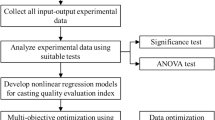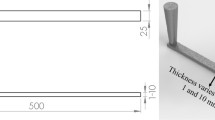Abstract
Process parameters are key to the production and cast quality of squeeze casting (SC). The exiting methods to obtain the process parameters are selected directly based on experimental results or based on the optimization through single models, which require more experiments, are expensive, time-consuming, and less adaptable. In this study, a process-parameter design method of SC based on ensemble learning is proposed, and a design and optimization framework for SC process parameters based on multi-model ensemble is established. Based on this framework, using the support vector machine (SVM), multivariate linear regression (MLR), and random forest (RF) model as the unit models, and an improved model assembling strategy (R2 weight assignment), the ensemble model (SMR) for optimizing the SC process parameters is established. Then, to obtain the optimal SC process parameters, the ant-colony-optimization (ACO) algorithm is adopted to solve the SMR model. The two application cases show that the proposed ensemble strategy is reasonable and effective; the ensemble model had higher prediction accuracy and stronger generalization ability, even in small data sample situations. Furthermore, it effectively improved the quality of cast by its designed process parameters, and the shrinkage porosity of Case 1 cast, using the designed process parameters, was reduced to 1.316%. Compared with the conventional methods for designing SC process parameters, the method based on the ensemble model is more efficient and accurate, and reduces the cost.







Similar content being viewed by others
Data availability
The raw/processed data required cannot be shared at this time as the data also forms part of an ongoing study.
Code availability
The custom code required to reproduce these findings cannot be shared at this time as the code also forms part of an ongoing study.
References
Ali MA, Ishfaq K, Jawad M (2019) Evaluation of surface quality and mechanical properties of squeeze casted AA2026 aluminum alloy using response surface methodology. Int J Adv Manuf Technol 103(9–12):4041–4054. https://doi.org/10.1007/s00170-019-03836-6
Li YY, Zhang WW, Zhao HD (2020) Research progress on squeeze casting in China. China Foundry 11(4):239–246
Jiang W, Zhu J, Li G, Guan F, Yu Y, Fan Z (2021) Enhanced mechanical properties of 6082 aluminum alloy via SiC addition combined with squeeze casting. J Mater Sci Technol 88:119–131. https://doi.org/10.1016/j.jmst.2021.01.077
Karthik A, Karunanithi R, Srinivasan SA, Prashanth M (2020) Microstructure and mechanical properties ofAA2219-TiB 2 composites by squeeze casting technique. Mater Today Proc 27(03):2574–2581. https://doi.org/10.1016/j.matpr.2019.10.143
Zhu J, Jiang W, Li G, Guan F, Yu Y, Fan Z (2020) Microstructure and mechanical properties of SiCnp/Al6082 aluminum matrix composites prepared by squeeze casting combined with stir casting. J Mater Process Technol 283:116699. https://doi.org/10.1016/j.jmatprotec.2020.116699
Hai BY, Xing SZ, Wei ZF, Xue WC (1897) DE YX (2016) Development status and applications prospect of squeeze casting technology. Adv Mater Res 538–541:1154–1157. https://doi.org/10.4028/www.scientific.net/AMR.538-541.1154
Deng JX, Xie B, You DD, Wang L, Wu XS, Liu G, Liang JW (2022) Process parameters design of squeeze casting through an improved KNN algorithm and existing data. J Manuf Process 84:1320–1330. https://doi.org/10.1016/J.JMAPRO.2022.10.074
Britnell DJ, Neailey K (2003) Macrosegregation in thin walled castings produced via the direct squeeze casting process. J Mater Process Tech 138(1):306–310. https://doi.org/10.1016/S0924-0136(03)00090-6
Gurusamy P, Hari KRS (2020) Influence of squeeze casting process parameter on Al/SiCp metal matrix composite. IOP Conf Ser Mater Sci Eng 988(1):012056. https://doi.org/10.1088/1757-899X/988/1/012056
Xu H, Li TS (2011) Research on process parameters optimization of squeeze casting for AZ91D magnesium alloy. Adv Mater Res 299:25–29. https://doi.org/10.4028/www.scientific.net/AMR.299-300.25
Akhil KT, Arul S (2018) Optimization of squeeze casting process parameters using Taguchi in LM13 matrix B4C reinforced composites. IOP Conf Ser Mater Sci Eng 310(01):17–19. https://doi.org/10.1088/1757-899X/310/1/012029
Azhagan MT, Mohan B (2020) Influence of squeeze cast process parameters on wear behavior of AA6061. Mater Today Proc 28(Pt2):931–935. https://doi.org/10.1016/j.matpr.2019.12.327
Yang LD, Pan CL, Wang LJ, Zhang ZF, Huang X, Qu SG, Li XQ (2021) Numerical simulation of 7050 aluminum alloy semi-solid squeeze casting. J Phys Conf Ser 2044(01):1–5. https://doi.org/10.1088/1742-6596/2044/1/012084
Yang HB, Wang GL, Chen XW, Xu DY (2013) The numerical simulation and optimization in squeeze casting of the air conditioning compressor front cover. Adv Mater Res 2675(803–803):317–320. https://doi.org/10.4028/www.scientific.net/AMR.803.317
Jiang JF, Yan J, Liu YZ, Hu GQ, Wang Y, Ding CJ, Zou DC (2022) Numerical simulation and experimental validation of squeeze casting of AlSi9Mg aluminum alloy component with a large size. Materials 15(12):4334–4358. https://doi.org/10.3390/MA15124334
Jiang JF, Li MX, Wang Y (2021) Research development of squeeze casting technology of aluminum alloy. The Chinese Journal of Nonferrous Metals 31(9):2313–2329. https://doi.org/10.11817/j.ysxb.1004.0609.2021-39788
Deng JX, Liu GM, Wang L, Yuan BY (2023) Huang HB (2023) Research progress of intelligent optimization design of manufacturing process parameters. Manuf Techn Mach Tool 05:74–80. https://doi.org/10.19287/j.mtmt.1005-2402.2023.05.010
Vijian P, Arunachalam VP (2007) Modelling and multi objective optimization of LM24 aluminium alloy squeeze cast process parameters using genetic algorithm. J Mater Process Technol 186(1–3):82–86. https://doi.org/10.1016/j.jmatprotec.2006.12.019
Chen ZY, Su XP, Kang ZY (2013) Optimization of low pressure casting process parameters for A356 aluminum alloy sleeve. Hot Work Technol. https://doi.org/10.14158/j.cnki.1001-3814.20212305
Ji QL, Xia ZL (2018) Optimization of hot extrusion forming parameters of AZ31 magnesium alloy based on neural network. Hot Work Technol 47(21):165–168. https://doi.org/10.14158/j.cnki.1001-3814.2018.21.042
Panicker PG, Kuriakose S (2023) Parameter optimisation of squeeze casting process using LM20 alloy: numeral analysis by neural network and modified coefficient-based deer hunting optimization. Aust J Mech Eng 21(2):351–367. https://doi.org/10.1080/14484846.2020.1842306
Víctor A, Isaac MDD, Rubén RF, Javier MM (2022) Minimally overfitted learners: a general framework for ensemble learning. Knowl-Based Syst 254:1–12. https://doi.org/10.1016/J.KNOSYS.2022.109669
Jovanović ŽR, Sretenović AA, Živković DB (2015) Ensemble of various neural networks for prediction of heating energy consumption. Energy Build 94:189–199. https://doi.org/10.1016/j.enbuild.2015.02.052
Tuarob S, Tucker CS, Salathe M, Ram N (2014) An ensemble heterogeneous classification methodology for discovering health-related knowledge in social media messages. J Biomed Inform 49:255–268. https://doi.org/10.1016/j.jbi.2014.03.005
Siwek K, Osowski S, Szupiluk R (2009) Ensemble neural network approach for accurate load forecasting in a power system. Int J Appl Math Comput Sci 19(2):303–315. https://doi.org/10.2478/v10006-009-0026-2
Sun Y, He K, Zhang ZN (2022) Multi-source information fitting regression integrated model of coefficient of friction. Journal of Tsinghua University (Science and Technology) 62(12):1980–1988. https://doi.org/10.16511/j.cnki.qhdxxb.2022.25.048
Zheng SY, Zhang LB (2022) Optimization of bumper process parameters based on integrated learning of PSO and stacking. Plastics 51(04):22–27
Zhou ZH (2016) Ensemble learning. In: Xue H (ed) Machine learning, 8th edn. Tsinghua University publishing house co., ltd, Peking, pp 171–196
Patro SP, Padhy N, Sah RD (2022) An improved ensemble learning approach for the prediction of cardiovascular disease using majority voting prediction. Int J Model Identif Control 41(1–2):68–86. https://doi.org/10.1504/IJMIC.2022.10052111
Melin P, Soto J, Castillo O, Soria J (2012) A new approach for time series prediction using ensembles of ANFIS models. Expert Syst Appl 39(3):3494–3506. https://doi.org/10.1016/j.eswa.2011.09.040
Ebadinezhad S (2020) DEACO: Adopting dynamic evaporation strategy to enhance ACO algorithm for the traveling salesman problem. Eng Appl Artif Intell 92(C):51–56. https://doi.org/10.1016/j.engappai.2020.103649
Breiman L (2001) Random forests. Mach Learn 45(1):5–32. https://doi.org/10.1023/A:1010933404324
Nickel S, Schröder W, Wosniok W et al (2017) Modelling and mapping heavy metal and nitrogen concentrations in moss in 2010 throughout Europe by applying random forests models. Atmos Environ 156:146–159. https://doi.org/10.1016/j.atmosenv.2017.02.032
Chen CQ, Xue XH (2022) A novel hybrid intelligent model for the prediction of creep coefficients based on random forest and support vector machine. Ocean Eng 266:5–14. https://doi.org/10.1016/J.OCEANENG.2022.113191
Fernandes CM, Mora AM, Merelo JJ, Rosa AC (2014) KANTS: a stigmergic ant algorithm for cluster analysis and swarm art. IEEE Trans Cybern 44(6):843–856. https://doi.org/10.1109/TCYB.2013.2273495
Mukherjee R, Chakraborty S, Samanta S (2012) Selection of wire electrical discharge machining process parameters using non-traditional optimization algorithms. Appl Soft Comput J 12(8):2506–2516. https://doi.org/10.1016/j.asoc.2012.03.053
Deng JX, Ye ZX, Shan LB, You DD, Liu GM (2022) Imputation method based on collaborative filtering and clustering for the missing data of the squeeze casting process parameters. Integr Mater Manuf Innov 11(1):1–12. https://doi.org/10.1007/S40192-021-00248-X
Zhang N, Zhang CY, Wang YC (2016) Optimization of hollow shaft squeeze casting process for high speed locomotive. Hot Work Technol 45(07):122–123+125. https://doi.org/10.14158/j.cnki.1001-3814.2016.07.034
Takayuki S, Fabien B, Manabu E (2023) Prediction of fatigue crack initiation of 7075 Aluminum alloy by crystal plasticity simulation. Materials 16(4):1595–1607. https://doi.org/10.3390/MA16041595
Li YZ, Yang HB, Xing ZW (2017) Numerical simulation and process optimization of squeeze casting process of an automobile control arm. Int J Adv Manuf Technol 88(1–4):941–947. https://doi.org/10.1007/s00170-016-8845-4
Zhang YX, Gao XD, Katayama SJ (2015) Weld appearance prediction with BP neural network improved by genetic algorithm during disk laser welding. J Manuf Syst 34:53–59. https://doi.org/10.1016/j.jmsy.2014.10.005
Liu NN (2012) Research on liquid forging technology of al alloys end cover of special vehicle. Dissertation, Harbin Institute of Technology
Acknowledgements
We would like to thank Editage (http://www.editage.cn) for English language editing.
Funding
This work was supported by the National Natural Science Foundation of China (grant no. 51965006, 51875209), Guangxi Natural Science Foundation (grant no. 2018GXNSFAA050111), and the Open Fund of National Engineering Research Center of Near-Shape Forming for Metallic Materials, the Key Laboratory of High Efficient Near-Net-Shape Forming Technology and Equipments for Metallic Materials (Ministry of Education) (grant no. 2019001), and 2022 China -ASEAN Information Harbor Project (grant No.7).
Author information
Authors and Affiliations
Contributions
Jianxin Deng: conceptualization, methodology, formal analysis, writing—original draft, writing—review & editing, supervision, project administration, funding acquisition. Ling Wang: methodology, software, validation, investigation, formal analysis, resources, data curation, writing-original draft, writing-review & editing, visualization. Gang Liu: Resources. Dongdong You: conceptualization. XiuSong Wu: Resources. JiaWei Liang: resources.
Corresponding author
Ethics declarations
Competing interests
The authors declare no competing interests.
Additional information
Publisher's Note
Springer Nature remains neutral with regard to jurisdictional claims in published maps and institutional affiliations.
Rights and permissions
Springer Nature or its licensor (e.g. a society or other partner) holds exclusive rights to this article under a publishing agreement with the author(s) or other rightsholder(s); author self-archiving of the accepted manuscript version of this article is solely governed by the terms of such publishing agreement and applicable law.
About this article
Cite this article
Deng, J., Wang, L., Liu, G. et al. Process parameters design of squeeze casting through SMR ensemble model and ACO. Int J Adv Manuf Technol 130, 2687–2704 (2024). https://doi.org/10.1007/s00170-023-12805-z
Received:
Accepted:
Published:
Issue Date:
DOI: https://doi.org/10.1007/s00170-023-12805-z




